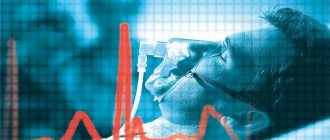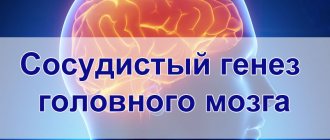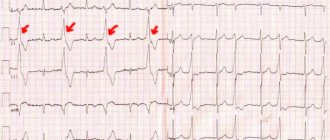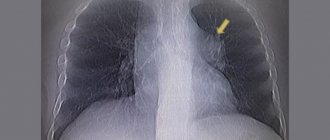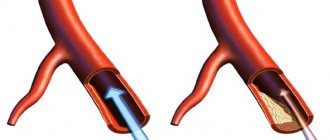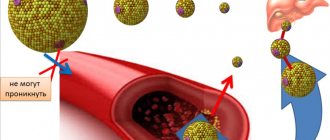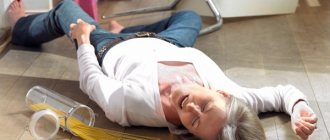What are the types and symptoms of vascular crisis?
In medicine, there are a large number of classification models that divide attacks according to certain characteristics. The most popular method is considered to be the separation method based on the location of hemodynamic disorders. According to this characteristic, crises are divided into 2 groups, each of which includes certain types of disorders in the body.
Systemic disorders
Hypertensive
An increase in blood pressure in a person may be indicated by the appearance of tinnitus.
A vascular crisis consists of a rapid increase in the level of upper and lower pressure, sometimes an increase in exclusively systolic values is observed. In this condition, the following symptoms appear:
- nausea with clouding of consciousness;
- throbbing pain in the head;
- noise in the ears;
- change in skin color;
- redness of the eyeballs;
- dyspnea;
- tremor in the limbs.
Hypotonic
The reasons for the development of this condition are varied, but the symptoms of the disorder are very obvious. The main indicator of a crisis is a sharp drop in blood pressure, which is accompanied by loss of coordination and nausea. The upper and lower extremities often tremble, and perspiration is systematically present on the forehead. A person is tormented by constant noise in the ears, the skin begins to turn pale.
Vegetative-vascular
The attack is observed against the background of strong psycho-emotional overexcitation, which entails a breakdown and panic attacks. The main set of signs by which the condition can be recognized includes:
A sign of a developing panic attack in a person is chills.
- chills;
- anxiety;
- rise or fall in blood pressure;
- hard breath;
- increased sweating;
- cardiopalmus;
- tachycardia;
- overexcitement;
- uncoordination of movements.
Non-systemic disorders
Cerebral crisis
The impetus for development is atherosclerotic disorders in the vessels of the brain, which is accompanied by acute pain in the head, loss of coordination, nausea and frequent vomiting. Patients experience memory impairment and a state of drowsiness in which a person cannot fall asleep. Cerebral vascular crisis of the brain in severe cases is manifested by a negative reaction to strong noise, speech and light, so the patient prefers to be in a secluded darkened place.
Migraine attack
The condition is always one-sided and is accompanied by increasing pressing pain. This occurs due to a sharp change in the tone of blood vessels, which move from narrowing to expansion. In this case, a person cannot make sudden movements, as this increases the pain. Noise and bright light are irritating factors, which cause dizziness and vomiting.
Angioedema
This pathology is characterized by the appearance of severe swelling on any part of the body.
The reasons for this condition are closely intertwined with an allergic reaction to a high content of a certain substance in the body, most often serotonin. In this case, there is an increase or swelling of an organ or part of the body. The main distinguishing feature of this condition is the absence of itching or change in skin color.
Angiotrophoneurosis
Pathology is not a pure representative of crisis. It is characterized by a rapid change in the narrowing and expansion of blood vessels in a specific area of the human body. Most often, the limbs are attacked, especially the fingers. Subsequently, this condition leads to serious abnormalities such as Raynaud's disease. This forces us to consider the condition as a separate illness, and not a type of crisis.
Symptoms
The symptoms of vascular crisis are influenced by the type of disorder. The symptoms depending on the types of crisis can be described as follows:
- Hypertensive. During an attack, blood pressure rises sharply, the patient feels trembling, nausea, fever, throbbing headache, and all blood supply to the body deteriorates. The attack is a manifestation of progressive hypertension. It is extremely important that when symptoms of a crisis appear, stop any physical activity, take the medicine prescribed by your doctor, lie down on a flat surface and call an ambulance.
- Hypotonic. It can be called the opposite of hypertensive. The patient's blood pressure drops sharply, which can lead to loss of consciousness, severe lethargy, and vomiting. The patient sweats, the skin turns pale, and often there is a “ringing in the ears.”
- Vegetative. Occurs as a result of disorders of the nervous system. The mechanism of development of this crisis has not been fully studied, but it is believed that the causes may be heredity, hormonal imbalance, constant stress, head injuries and violations of work and rest patterns. The attack manifests itself as follows: the patient begins to choke, his limbs shake violently, his head hurts, his heart “freezes,” he is overcome by anxiety, turning into panic, and there is a feeling of the unreality of what is happening. The crisis lasts approximately 15-25 minutes, but depending on the characteristics of the body, the time can be shortened or increased. Even after experiencing a single attack, most patients are afraid to be left alone, they are afraid of a recurrence, they worry that they will only harm themselves, since the central nervous system is in constant excitement and can provoke a new panic attack.
- Migraine. This pathology is characterized by attacks of severe pain in the temples and occipital region. The patient reacts painfully to light and loud sounds. The cause of the attack is angioedema.
- Angiotrophoneurosis. The manifestation is quite rare. Characterized by alternating narrowing and expansion of capillaries. Over time, attacks become regular, as a result of which the structure of organs is disrupted.
- A cerebrovascular crisis is usually associated with changes in cerebral vessels of an atherosclerotic nature. The attack is accompanied by disturbances in the functioning of the vestibular apparatus, severe headaches, nausea, and vomiting.
Patients need to be attentive to the above alarming symptoms and, if one or more are present, be sure to take appropriate measures.
Basic diagnostic measures
In order to provide the necessary assistance to the patient, his blood pressure is first checked.
If the patient exhibits symptoms of a crisis, he is hospitalized and undergoes an initial examination, during which the details of his life and the development of the disease are clarified. After this, to confirm the diagnosis, he is sent for additional examinations, which include:
- measuring blood pressure readings;
- electrocardiogram;
- echocardiography;
- Ultrasound;
- CT;
- treadmill test;
- general examination of blood and urine;
- blood chemistry;
- examination for thyroid hormones.
Causes and mechanisms of development
The mechanism of development of the pathology depends on its type: loss of vascular tone in the angiohypotonic type, spasm or blockage of blood vessels in the ischemic type, and their combination in the mixed type. The main reason for the development of hypertensive cerebral crisis is a sharp increase in pressure against the background of arterial hypertension. The following factors lead to this condition:
- stress and nervous tension;
- diabetes;
- dyscirculatory encephalopathy in the final stages;
- rapidly progressing arterial hypertension;
- violation of diet (consumption of excessive amounts of salt, fatty and fried foods, alcohol);
- sudden changes in weather.
The main consequences of the disease
Angina pectoris can develop in a patient if his pathological condition is not stopped in time.
If high blood pressure is not treated in a timely manner, the body can reach a crisis state, which can provoke disturbances in other body systems, for example, disturbances in cerebral vascular tone. These include:
- disorders of the central nervous system (coma or clouding of consciousness);
- stroke;
- angina pectoris;
- swelling of the airways;
- rupture of the heart muscle;
- aneurysm;
- heart failure.
Self-administered or incorrectly selected therapy can lead to a deterioration in a person’s condition or cause death.
Traditional medicine
A crisis develops as a consequence of a disturbance in vascular tone, resulting in either a spontaneous increase in blood pressure or a sharp decrease in blood pressure. Due to such surges, some organs and tissues do not receive the required portion of circulating blood. Traditional methods are aimed at balancing the functioning of blood vessels.
Among these methods are the positions:
- Aronia, juice, and jam from it will help reduce high blood pressure; if you need to increase blood pressure, you need to drink a mug of natural black coffee or sweet tea;
- A cotton pad or cloth soaked in apple cider vinegar will normalize the pressure if applied to the heel area;
- If the increase in blood pressure was mediated by stress or overexertion, then you need to resort to an infusion of valerian and motherwort herbs, pour a tablespoon of it with a cup of boiling water, leave for an hour, take fifty milliliters 3 times a day;
- Combine twenty grams of dried yarrow with four hundred milliliters of water, put on low heat for about fifteen minutes, leave for a little, filter, consume thirty milliliters daily;
- Squeeze a couple of cloves of garlic, rub through cheesecloth, add an identical amount of honey to the resulting juice, mix thoroughly, consume a tablespoon twice a day;
- 2 tablespoons of dried astragalus herb should be poured with three hundred boiled water, taken in a volume of 3 tablespoons daily, 3 times a day.
The decision to take any of the designated folk remedies cannot be made at random; there needs to be clear control from the attending physician, who can accurately diagnose the problem, the degree of severity and individual intolerance to the components, on the basis of which a prescription will be issued and a course of treatment determined in one way or another.
Healing herbs, mixtures and infusions are not able to eliminate the disease, so drug treatment takes the main position.
How to prevent the development of the disease?
A vascular crisis may recur, so doctors recommend following a number of preventive rules. This will help improve the health of the body, increase its endurance and normalize blood pressure levels. The main recommendations include:
Swimming helps strengthen the human body.
- Mode. To normalize the condition, you need to develop a clear work and rest schedule.
- Exercises. Outdoor exercise and swimming will help increase the physical level of the body.
- Lifestyle. Doctors strongly recommend giving up bad habits, since nicotine and alcohol dramatically affect blood pressure levels.
- Stress. A crisis often occurs from increased brain activity, which depresses a person due to constant psycho-emotional stress. You need to eliminate all negative influences, take a sedative and relax.
In medical practice, vascular crises occur frequently, since the functioning of the circulatory system is influenced by a large number of external and internal factors. The reasons that cause disorders are varied and the clinical picture may vary depending on the type of crisis. Self-prescribed treatment can provoke negative consequences, so it is recommended to immediately seek advice from a specialist.
Symptoms
Symptoms of vascular crisis depend on the type of pathology that has developed.
Most often, a vascular crisis manifests itself in the form of the following symptoms:
- attacks of throbbing or dull headache;
- increase or decrease in blood pressure;
- nausea, dizziness, loss of consciousness;
- ringing in the ears, spots before the eyes;
- general malaise, insomnia, attacks of unexplained anxiety;
- cardiopalmus;
- numbness of the limbs;
- migraine;
- severe sweating;
- shortness of breath, heart pain;
- impaired coordination of movements;
- memory disorders;
- slurred speech.
Main symptoms and signs of vascular crisis
If at least a few of the above symptoms appear, you must seek qualified help from a doctor to conduct all the studies necessary to make a diagnosis.
Principles of therapy for cerebral crises
A hypertensive cerebral crisis first of all requires hospitalization of the patient and a decrease in pressure to normal levels. It should be remembered that a sharp decrease in pressure has an adverse effect on the patient’s well-being, so blood pressure must be lowered gradually.
In this case, sodium nitroprusside, nitroglycerin, and beta-blockers are administered intravenously by drip or stream. To relieve vascular spasm, antispasmodics based on drotaverine (“No-shpa”) or papaverine can be used.
In case of psycho-emotional overexcitation, sedatives or tranquilizers (Seduxen) are prescribed. For angiohypotonic type of cerebral crisis, venotonic drugs are used.
During the rehabilitation period, it is recommended to continue antihypertensive therapy. Additionally, nootropics are prescribed - drugs that improve blood circulation in the brain.
These are Cinnarizine, preparations based on piracetam (Nootropil) or phenibut (Bifren), herbal preparations based on ginkgo biloba (Bilobil). The administration of magnesium and B vitamins (“Magne-B6”, “Neurorubin”) will also be useful, since they improve the condition of the nervous system and make it easier to endure stress and emotional stress.
Treatment of a hypertensive crisis is carried out based on the severity of the attack, the type of condition being diagnosed and the characteristic symptoms. In any case, the patient requires hospitalization, where, under the supervision of doctors, the condition will be stabilized, neutralizing the negative impact of a hypertensive crisis.
But there are certain procedures that should be taken first, regardless of the type of pathological condition, while emergency doctors are on the road. If a person was diagnosed with hypertension before the attack, then the medicine cabinet must contain drugs that lower blood pressure.
But it should be understood that the pressure should be relieved gradually so as not to harm the body and stabilize the condition.
Until the condition normalizes, regardless of the type of hypertensive crisis, the person should be in a half-sitting position, which will prevent attacks of suffocation.
If the condition has not improved, then diuretics will help reduce headaches during a hypertensive crisis, which will allow you to remove excess fluid. If you feel pain in the heart area, you should take nitroglycerin or validol. To reduce chills in a patient, it is necessary to cover him with a blanket, but at the same time open the window slightly to provide access to fresh air.
Important! When providing assistance during a hypertensive crisis, a person can be given only those medications that were previously prescribed by a doctor. You cannot experiment and use other types of drugs, as these manipulations can lead to further deterioration of the condition.
Further treatment of any type of pathological condition should be carried out in a hospital after examinations. In this case, a prerequisite is the need to comply with bed rest until the patient’s condition is completely stabilized.
Methods for diagnosing hypertensive crisis
A hypertensive crisis can only be diagnosed by a specialist. A routine examination necessarily includes the following procedures:
- ECG;
- daily blood pressure monitoring;
- rheoencephalography;
- ECHO-EG;
- EEG;
- Doppler ultrasound of cerebral vessels;
- ophthalmoscopy;
- perimetry;
- MRI of the brain;
- consultation with an ophthalmologist.
The patient can be prescribed all procedures or some of them. It all depends on the patient’s condition and the classification of the hypertensive attack.
The first thing that makes you think about the onset of an attack is the clinical picture: a sharp complication of the condition against the background of a sharp jump in blood pressure to numbers from 180 mm Hg. Art. for systolic and from 110 mm Hg.
Art. for diastolic. A mandatory research method is ECG (electrocardiography) to study the condition of the heart muscle.
A general and biochemical blood test and a general urinalysis are performed as standard. Among the specific diagnostic methods, the following are distinguished:
- EEG (electroencephalography);
- Dopplerography of cerebral vessels;
- rheoencephalography;
- CT or MRI of the head;
- 24-hour blood pressure monitoring;
- fundus examination;
- X-ray of the chest cavity.
Timely diagnosis of pathology helps prevent its progression and the development of complications.
Important! Cerebral hypertensive crisis is considered a condition that requires timely and adequate treatment, regardless of the type, so you should not self-medicate, as this leads to irreversible processes in the body.
Diagnosis of various types of pathological conditions should be carried out by a highly experienced therapist, cardiologist or neurologist. If you have at least some obvious symptoms of the disease, you should not hesitate, since any deviation from the norm is best treated at the initial stage.
The diagnosis of each type of pathological condition is initially established by clinical symptoms and on the basis of recorded elevated blood pressure levels. Subsequently, when the patient has received the necessary assistance, certain instrumental studies are carried out to identify the actual state of the cardiovascular system, blood flow patency and the type of pathological condition.
Diagnosis of a hypertensive crisis consists of the following types of examinations:
- regular monitoring of blood pressure levels;
- rheoencephalography is a method that makes it possible to identify the level of elasticity, tone and activity of blood vessels in the brain;
- electroencephalography - allows you to monitor the slightest changes in the cerebral cortex;
- electrocardiography - determines the actual state of the heart using electrical impulses;
- MRI - helps to identify vascular pathologies and possible problems of the nervous system;
- Doppler ultrasound is a non-invasive way to examine blood flow.
In addition to basic examinations, the attending physician may prescribe an additional consultation with an ophthalmologist and perimetry and ophthalmoscopy in order to identify negative changes in the organs of vision as one of the complications of a hypertensive crisis.
Based on the measurements, analyzes and examinations, a diagnosis is established and appropriate treatment is prescribed based on the identified type of pathology and the patient’s condition.
According to the international classification ICD-10, cerebral hypertensive crisis is assigned different codes, which depends on the associated complications, development factors and type of pathological condition: I10 – I15, O10-O11.
Diagnosis of hypertensive cerebral crisis is carried out by a therapist, cardiologist or neurologist. The disease is identified based on its inherent clinical symptoms, as well as previously taken into account data indicating the development of symptoms.
If we talk about instrumental studies, they are usually carried out after first aid is provided to the person. Instrumental studies are aimed at deeper diagnosis of cerebral circulation, as well as the state of the cardiovascular system.
Typically such studies include:
- daily blood pressure measurement;
- ECG;
- EEG;
- rheoencephalography;
- Doppler ultrasound;
- ophthalmoscopy;
- MRI of the brain;
- perimetry.
It is necessary to distinguish a hypertensive cerebral crisis from ischemic or hemorrhagic strokes, acute hydrocephalus (which is observed with brain tumors).
First aid in a crisis situation
Note that many people are confused and do not know how to act with dystonia, even those who suffer themselves. For example, during an acute crisis, you need to quickly drop 20-25 heart drops onto a piece of refined sugar or mix with water. If you have a rapid heartbeat, you can take an anaprilin tablet. A couple of diazepam tablets under the tongue will help cope with nervous excitement.
To cope with the problem of difficult breathing, it is best to use a regular paper bag. Inhale and exhale through it until function is restored.
A frequent attack of dystonia is a short-term loss of consciousness, simply put, fainting. Before an attack, the patient turns pale, feels dizzy, has dark vision, lacks air, ringing in the ears, and nausea. This condition is caused by a violation of vascular tone, blood outflow from the brain, and a decrease in blood pressure.
To prevent fainting, you need to urgently sit down or lean on something.
Preventive actions for presyncope will be:
- urgently sit down or lean on something;
- loosen belts, ties and buttons on clothes so that nothing is squeezing;
- sit down so that your legs are higher than your head, for example, lower your upper body;
- provide a flow of fresh air if an attack occurs indoors;
- rubbing your feet and splashing your face with cold water.
Consciousness is usually restored within a few minutes. After bringing the person to his senses, give him warm sweet tea or coffee, you can take valerian.
But this is only first aid, that is, surgical aid, which brings relief, but does not cure the disease.
At the moment, nothing more effective than conservative methods for the treatment of dystonia has been invented. The patient will have to completely reconsider his lifestyle in the future.
- Maintain a daily routine with a sleep duration of at least 8-10 hours. For sleep, it is advisable to arrange a comfortable bed of medium hardness. Sleep in a well-ventilated area. During the day, reduce the time spent in front of the TV or computer; if the latter is not possible, be sure to take technical breaks. Daily walks in the fresh air. Alternating physical and mental stress.
- Physical exercise. This could be morning exercises, jogging, walking, cycling, aerobics, exercise equipment. As for training on exercise machines, you need to choose those where your head will not be below chest level. You should not choose gymnastic exercises with sharp turns of the head, body or large amplitude. Workouts don't have to be exhausting or difficult.
Read also: Functional cardialgia
A revision of the diet involves reducing the amount of salt, fatty meat, sweets and starchy foods. We lean on foods high in magnesium and potassium.
- Physiotherapy.
- Water procedures.
- Acupuncture.
- Massotherapy.
- Psychological correction.
- Herbal and drug therapy.
You should not self-medicate and prescribe medications to yourself. Manifestations of dystonia are individual for each case, therefore, the doctor prescribes medications individually. This takes into account: crisis symptoms, the patient’s age, the presence of other diseases, the individual predisposition of the body to the action of certain drugs.
By adhering to the treatment instructions, you can nullify crisis attacks on the body or at least stabilize the condition to the level of rare manifestations. It depends only on the patient whether he will be able to avoid dystonic crises in the future.
What is it like?
The causes of the development of pathology are various factors. They determine the type of crisis:
Don't tolerate high blood pressure
Now hypertension can be cured by restoring blood vessels...
>
- Angiohypotonic. Develops due to decreased tone of brain capillaries. As a result, intracranial pressure increases and congestion develops.
- Ischemic. The cause is blockage of blood vessels. This leads to a slowdown in the process of saturating the body with oxygen.
- Difficult. Usually combines both of these types.
In addition, the attack is divided according to severity:
- 1st (easy). Symptoms are not clearly expressed. The attack lasts no more than 2 hours.
- 2nd (middle). The symptoms are clearly visible and often affect certain areas of the brain. The attack lasts about 4 hours.
- 3rd (heavy). The symptoms are as clear as possible. The duration of the attack is one day.
There are uncomplicated and complicated forms of the crisis. In case 1, the attack does not last long and, with timely treatment, does not have serious consequences. In the 2nd option there are complications: pulmonary edema, stroke, cerebral edema, renal and left ventricular failure, angina pectoris, heart attack.
We recommend reading: Help in treating hypertensive crisis at home
Causes and mechanisms of development
These attacks appear in the presence of hypertension and are one of the types of possible complications of the disease. This is due to the high load on the organ that controls the tone and elasticity of blood vessels.
During normal functioning, the blood flow regulation system in the brain completely controls the level of blood pressure, and when it changes upward, it increases vascular tone. This factor helps prevent excess blood from entering the vessels.
If vascular tone does not rise to the required level, then a hypertensive crisis occurs. The basis of this condition is stagnation in the vessels, accompanied by excessive accumulation of fluid. This is considered to be the cause of increased intracranial blood pressure.
Important! Previously, cerebral hypertensive crisis manifested itself in older people, but now doctors note disappointing statistics that every year the risk group is noticeably younger.
Why does it crash?
A vascular crisis can occur as a result of the development of any serious illness in the body. Most often it is one of the characteristic symptoms of the following series of diseases:
- Raynaud's disease
- Quincke's edema (angioedema)
- vegetative paroxysms
- congenital heart defect
- arterial hypertension
- angiotrophoneurosis
- hypertension
- cervical osteochondrosis
In addition, the following may be the cause of the development of vascular crisis:
- An imbalance in the body of vasoactive substances (released by vascular endothelial cells), as well as changes occurring in the vascular receptor apparatus.
- Changes in the structure of the walls of blood vessels, which leads to disruption of the elasticity of tissues and their natural functions.
- This often occurs as a result of inflammatory processes in the body, disruption of normal metabolism or atherosclerotic changes.
- Hormonal changes in the body that accompany menopause, gynecological inflammatory diseases and puberty.
- Pathological processes in the endocrine system, central and peripheral nervous systems.
- Congenital and acquired defects of the cardiovascular system, ischemic disease.
- Incorrectly selected therapeutic procedures for the treatment of various diseases. Vascular crisis appears as a consequence of improper treatment.
- Inflammation of the nervous system.
- Congenital pathology of the cervical aorta.
Sometimes it is quite difficult to determine the exact cause of an attack of vascular crisis. This is especially difficult to do in the vegetative-vascular form of this disease, the mechanism of occurrence of which is not fully understood. Among the known reasons for its development are:
- hereditary factor
- hormonal imbalance in the body
- emotional overload and frequently recurring stressful situations
- recent traumatic brain injuries
- pathological changes in the nervous system
- disruption of normal daily routine

